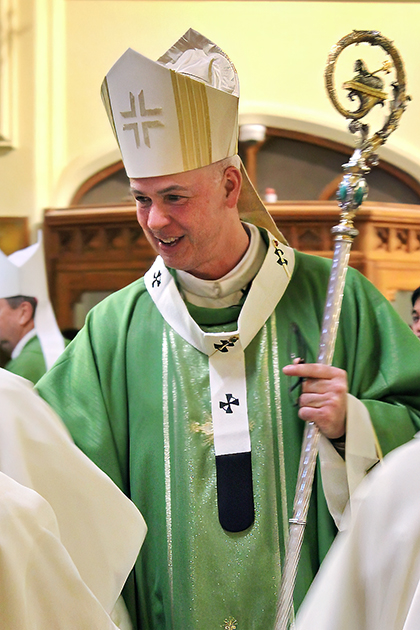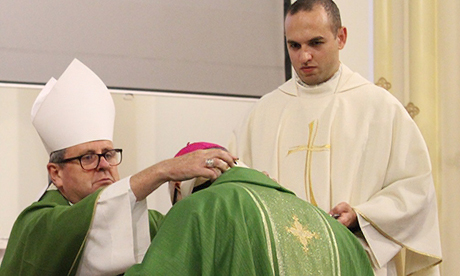Archbishop Paul Martin received his Metropolitan Archbishop’s pallium during the 5pm Mass at St Mary of the Angels church in Wellington on Sunday 5 November.
Martin is the Archbishop of Wellington, New Zealand.
He had been expecting to receive the pallium from the Papal Nuncio, Archbishop Novatus Rugambwa. But Rugambwa – the Pope’s diplomatic representative in New Zealand – suffered a severe stroke on 27 October and is in Wellington Hospital.
Initially, in Rugambwa’s absence, there was some confusion about whether the ceremony would proceed.
However, clarification came when Martin chose the Bishop of Auckland and President of the New Zealand Catholic Bishops Conference, Stephen Lowe, to confer the pallium.
A metropolitan archbishop wears the pallium whenever he is present at a liturgical ceremony as Metropolitan. He also wears it for archdiocesan ceremonies such as the Chrism Mass and any major ceremonies at the Metropolitan Cathedral.
“It’s an ancient part of our Church tradition and I am extremely humble wearing it today” Martin told the crowded church in his homily during the Mass.
The pallium – a white band of lamb’s wool adorned with black crosses, worn over the shoulders and chasuble – is the traditional, historic insignia of a metropolitan archbishop of the Catholic Church. It is bestowed by the Pope.
Pallium history in the Archdiocese of Wellington
Cardinal Reginald Delargy received his pallium at the 75th Jubilee of Holy Cross College, the National Seminary in Mosgiel, Dunedin.
Cardinal Tom Williams’ pallium arrived by mail, while Cardinal John Dew received his at the hands of Pope Francis on the Feast of Saints Peter and Paul in Rome.
Pope Francis has more recently returned to the tradition of blessing the palliums on that feast day.
He then sends them to the papal nuncio in each country for the nuncio to confer upon the local Metropolitan Archbishop at a suitable moment.

Archbishop Paul Martin, wearing his Pallium
History of the Pallium
Every year, on the feast of St Agnes (21 January) two lambs are brought from Tre Fontane, the site of St Paul’s martyrdom. The lambs are brought to the Basilica of St Agnes on the Via Nomentana in Rome.
After the lambs are blessed, they are taken and presented to the Pope.
They then remain in the care of the Sisters who reside at the Basilica of St Cecilia in Trastevere in Rome.
Just before Easter, these lambs are shorn, and their wool is used in making the palliums for newly-appointed metropolitan archbishops.
Once entirely handmade by the Sisters, the sheer number of archbishops needing a pallium each year has made it impossible to continue with that practice.
Instead, the Sisters select a company to manufacture them.
Each pallium contains a portion of the wool shorn from the two lambs.
- Supplied: NZCBC
News category: New Zealand.




